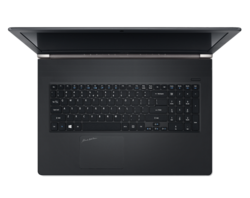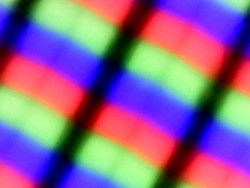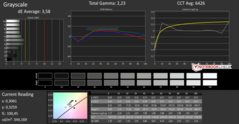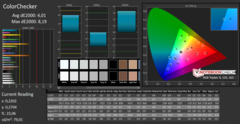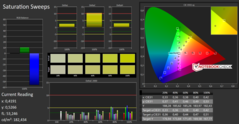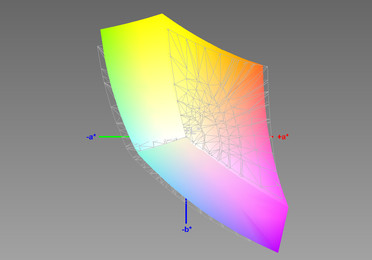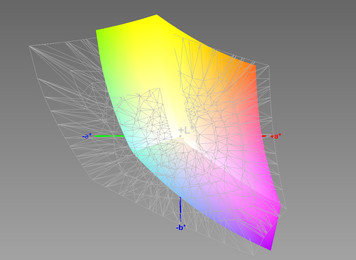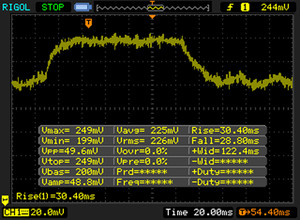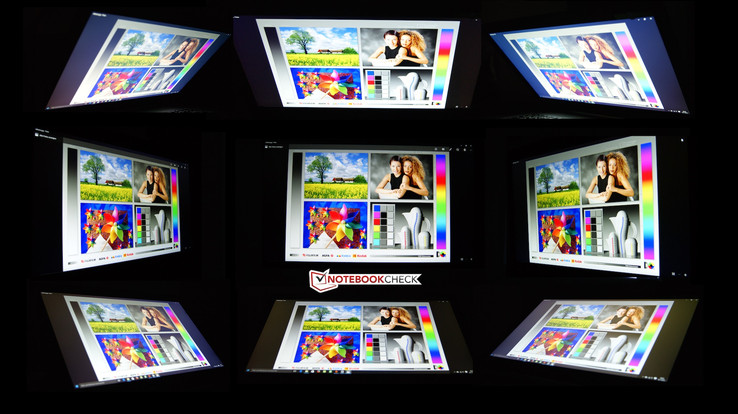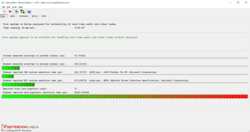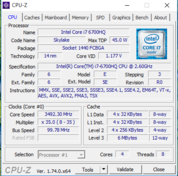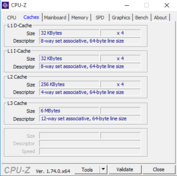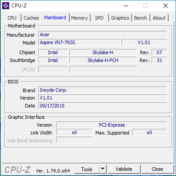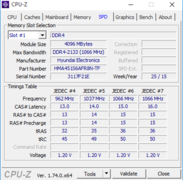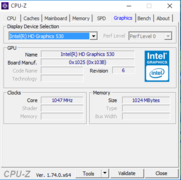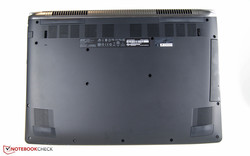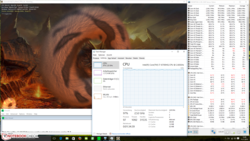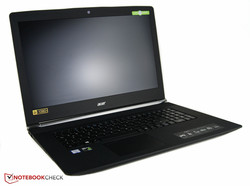Acer Aspire V Nitro Black Edition VN7-792G-74Q4 Notebook Review

For the original German review, see here.
Acer presented us its Aspire Nitro line for the first time a bit over a year ago. Its successful total concept distinguished it from the masses of multimedia laptops. Intel's new Skylake generation is a must for the latest version. In addition to the new processors, the manufacturer relies on DDR4 memory and a new USB Type C port including Thunderbolt 3 support. As known from Acer, various configurations are available. Among them one high-resolution 4K screen.
Our review sample has been furnished with a high-performance Intel Core i7-6700HQ, 8 GB of working memory, a 1 TB SSHD (8 GB cache), an Nvidia GeForce GTX 960M, and an FHD screen. It is currently sold for approximately 1230 Euros (~$1308). The price for top configuration with a Blu-ray drive, 4K screen, additional 256 GB SSD and 16 GB of working memory is 1900 Euros (~$2021).
The Asus N551JW, MSI GP62 2QE and Schenker XMG A705 are rivals. Of course, we would like to make comparisons with our previously tested models from this line (Acer Aspire V Nitro 7-791G, Acer Aspire V 17 Nitro VN7-792G-55SF). The looks and some other aspects are the same in this version. Details can be found in our in-depth review of the Acer Aspire V 17 Nitro (VN7-791G-759Q).
Connectivity
Besides the basic configuration known from the former models, our review sample now features a USB Type C port. It additionally provides a Thunderbolt 3 interface that makes data rates of up to 40 Gbits possible. More details can be found in Intel's specifications. The interfaces are positioned on the laptop's rear, which prevents cables from connected peripherals from interfering in the workspace.
Communication
An Atheros/Qualcomm QCA6174 802.11 ac module takes care of wireless communication. The connection is performed via an internal LP-PCIe interface and is to achieve a throughput of up to 866 Mbps.
Acer's Aspire V17 has also been furnished with an Ethernet port. Cabled communication can reach data rates of up to one gigabit per second.
A real-world situation is created in the writer's personal scenario. Data is sent from an NAS storage via the internal network here, using a FRITZ!Box 7490. The router is positioned one story below our multimedia laptop, which corresponds to a linear distance of approximately three to four meters. An Apple iMac (Late 2013) that supports the IEEE 802.11 ac standard (1300 Mbits gross) serves as the reference device.
The Aspire V 17 achieved 96 MB/s via a LAN connection and approximately 54 MB/s via the Wi-Fi connection. The iMac's results are worse with 90 MB/s (LAN) and 36 MB/s (Wi-Fi). We did not observe any issues like lags or unusually high pings in the practical test (playing Battlefield online), either.
We also tested the SD-card reader's transfer speed with a Toshiba Exceria Pro SDXC 64 GB UHS-II. According to the AS SSD benchmarks, the sequential read rates are roughly 27.3 MB/s and the sequential write rates 29.7 MB/s. We copied 250 JPG files from the SD card to the system to simulate a real-world scenario. The average transfer rate after five runs was 14 MB/s - a rather poor outcome.
Accessories
Our review sample was shipped without accessories. However, the manufacturer does not offer any product-specific accessories, either.
Maintenance
Acer again omits maintenance hatches in its newest version of the Nitro line. The entire base unit has to be removed for repairs. That enables accessing the fans, battery, hard drive and Wi-Fi module (with antenna). More details can be found in our former review of the Aspire V 17.
Warranty
The two-year warranty ex-factory includes a pick-up & return service. Further warranty upgrades can be ordered on the manufacturer's page. For example, a four-year carry-in with traveler's warranty costs 80 Euros (~$85).
Input Devices
Keyboard
A chiclet keyboard with a numpad is installed in Acer's Aspire V 17 Nitro. Considerable effort has been invested here compared with the former unit: The keyboard no longer yields and the drop has also been improved. The surface is lightly roughened, providing enough grip. All keys are mounted firmly and do not wobble excessively at the edges. The pressure point is convincing and is suitable even for elongated office work. The stroke noise while typing is sooner subdued and not distracting. A red, one-level keyboard backlight is installed for typing in the dark. Although it looks impressive it could be somewhat brighter. Multi-level brightness control would have been nice.
Touchpad
The implemented touchpad's size of 10.6 x 7.8 cm is sufficient. Its surface texture is neither too rough nor too sleek, which results in close to ideal gliding traits. The input device itself responds well even in the problematic corners. Multitouch gestures also function without snags. The only annoying flaw: Inputs are accompanied by a clattering noise.
Display
A screen with a resolution of 1920x1080 pixels is installed in the present multimedia laptop. Acer changed the display builder for the current models. An LG panel was used in our April review. The screen now comes from AU Optronics. An IPS panel is still installed in all screens, which is not a matter of course. By comparison: MSI's GP62 and Schenker's XMG A705 are both furnished with viewing-angle dependent TN screens. Our review sample's average brightness of 326 cd/m² is roughly 30 cd/m² higher than the average of the 17-inch multimedia laptops tested in the past 12 months. A different screen from AU Optronics was installed in our review of Acer's Aspire V 17 Nitro VN7-792G-55SF. It only achieved a brightness of 261 cd/m².
A 4K screen can be selected in place of the Full HD model. The price, including an additional 256 GB SSD, starts at 1800 Euros (~$1915).
| |||||||||||||||||||||||||
Brightness Distribution: 88 %
Center on Battery: 346 cd/m²
Contrast: 1081:1 (Black: 0.32 cd/m²)
ΔE Color 4.01 | 0.5-29.43 Ø5
ΔE Greyscale 3.58 | 0.57-98 Ø5.3
66.7% AdobeRGB 1998 (Argyll 2.2.0 3D)
91.3% sRGB (Argyll 2.2.0 3D)
67% Display P3 (Argyll 2.2.0 3D)
Gamma: 2.23
The contrast of 1081:1 is also noted positively. It is much higher than in the comparison devices of the other laptop manufacturers. The average of all review samples from the past 12 months is 765:1. The black level of 0.36 cd/m² can be considered as decent although it does not quite produce a natural black tone.
In our next step we analyze the color and grayscale shifts compared with the sRGB reference. The DeltaE shift in the CalMAN Grayscale assessment is a quite good 3.58. The shift in CalMAN ColorChecker is identically good at 4.01.
Our Aspire Nitro presents good rates but, unfortunately, we have to point out an unwelcome irregularity of our review sample. The matte screen texture leads to a slightly distorted perception of the color reproduction. That results in, for example, colored artifacts on a white screen or an effect often described as "chroma noise". Compared with other matte screens, it is evidently stronger in the present device and might possibly annoy more sensitive users.
We also checked whether the review sample is suitable for outdoor use. Although the size and weight make outdoor use difficult, the matte screen is impressive thanks to its sufficient brightness. The screen cannot compensate for direct sunlight, making use only under cloudy skies recommendable.
Display Response Times
| ↔ Response Time Black to White | ||
|---|---|---|
| 28 ms ... rise ↗ and fall ↘ combined | ↗ 7 ms rise | |
| ↘ 21 ms fall | ||
| The screen shows relatively slow response rates in our tests and may be too slow for gamers. In comparison, all tested devices range from 0.1 (minimum) to 240 (maximum) ms. » 67 % of all devices are better. This means that the measured response time is worse than the average of all tested devices (21.5 ms). | ||
| ↔ Response Time 50% Grey to 80% Grey | ||
| 58 ms ... rise ↗ and fall ↘ combined | ↗ 30 ms rise | |
| ↘ 28 ms fall | ||
| The screen shows slow response rates in our tests and will be unsatisfactory for gamers. In comparison, all tested devices range from 0.2 (minimum) to 636 (maximum) ms. » 93 % of all devices are better. This means that the measured response time is worse than the average of all tested devices (33.8 ms). | ||
Screen Flickering / PWM (Pulse-Width Modulation)
| Screen flickering / PWM not detected | ||
In comparison: 53 % of all tested devices do not use PWM to dim the display. If PWM was detected, an average of 17933 (minimum: 5 - maximum: 3846000) Hz was measured. | ||
The high-quality IPS panel allows, for example, watching videos from virtually every viewing angle. Only the brightness distorts slightly depending on the screen's alignment. We have previously seen that this screen technology is not a matter of course in the comparison devices.
Performance
Acer's Aspire V 17 Black Edition is prepared for almost every application field. Apart from multimedia and office use, our review sample can also cope with the gaming sector. Even up-to-date games will be rendered smoothly with this configuration.
The manufacturer relies on a new i7 CPU from the Skylake architecture and continues to use a dedicated Nvidia graphics card. A special bonus: The installed DDR4 memory. Our laptop features two 4 GB modules that operate in dual-channel mode. Like known from the former Nitro line, Acer offers several versions. Options are an Intel Core i5 CPU as a frugal processor (Intel Core i5-6300U) or a performance version (Intel Core i5-6300HQ).
Furthermore, buyers can optionally add different hard drive models (SSD, HDD, SSHD). In addition to the working memory capacity of 8 or 16 GB, an Nvidia GeForce GTX 950M can also be ordered. An especially interesting model is, for example, the extended configuration of our review sample with a 4K UHD screen and second 256 GB SSD storage device. However, it also costs considerably more with a purchase price of 1800 - 1900 Euros (~$1915 - ~$2021).
Processor
The manufacturer installs an Intel Core i7-6700HQ in our review sample. The used processor was premiered in September this year and is the biggest innovation of the Nitro line. The processor unit used here clocks at 2.6 GHz and can reach speeds of up to 3.5 GHz via Turbo Boost (4 cores max. 3.1 GHz). Its four cores place it in the upper performance class. In terms of performance, it is slightly above the level of an Intel Core i7-4810MQ and Intel Core i7-4900M.
We compare the review sample with its rivals and previously tested Black Edition models still based on a CPU from the Haswell architecture in Cinebench R15.
The Aspire V 17 almost always clocked stably at 3.1 GHz in the benchmarks. This good utilization of the Turbo mode is rewarded with a good score of 679 (multi-core test). Thus, it scores 9% better than a Schenker XMG A705 that features the same CPU.
An interesting fact: Our review sample achieves the same score as Asus' N551JW but is 6% better than an Aspire V Nitro 7-791G. That is remarkable seeing that both laptops sport the same Intel Core i7-4720HQ.
Our review sample scored as expected as long as it was connected to an outlet. Unfortunately, the results declined in battery mode. The score in Cinebench 15 dropped to 414 here.
System Performance
Our multimedia device is powered by high-performance hardware. Applications always make a smooth impression. Unfortunately, the response time is not as good. The reason: The SSHD cannot replace a genuine SSD storage. PCMark 7 is used to provide concrete data about working speed. In total, the laptop scores quite well with almost 4800 points in PCMark. However, the rivals based on an SSD achieve better scores. For example, Schenker's XMG A705 accomplishes 6052 points. Even the former Acer Aspire V Nitro 7-791G achieves a better score (5669 points).
| Acer Aspire V Nitro Black Edition VN7-792G-74Q4 GeForce GTX 960M, 6700HQ, Toshiba MQ02ABD100H | Asus N551JW-CN094H GeForce GTX 960M, 4720HQ, Kingston SMSM151S3128GD | MSI GP62-2QEi781FD GeForce GTX 950M, 5700HQ, Micron M600 MTFDDAV512MBF M.2 | Acer Aspire V Nitro 7-791G-70TW GeForce GTX 960M, 4720HQ, Kingston RBU-SNS8100S3256GD | |
|---|---|---|---|---|
| PCMark 7 | 9% | 43% | 25% | |
| Score | 4671 | 4939 6% | 6411 37% | 5669 21% |
| Lightweight | 4065 | 4835 19% | 6422 58% | 5486 35% |
| Productivity | 3663 | 4540 24% | 5727 56% | 4753 30% |
| Entertainment | 3963 | 3580 -10% | 4766 20% | 4105 4% |
| Creativity | 7981 | 8188 3% | 11607 45% | 10091 26% |
| Computation | 17552 | 15364 -12% | 21912 25% | 19135 9% |
| System Storage | 3359 | 4582 36% | 5453 62% | 5120 52% |
| PCMark 7 Score | 4671 points | |
| PCMark 8 Home Score Accelerated v2 | 3751 points | |
| PCMark 8 Creative Score Accelerated v2 | 4320 points | |
| PCMark 8 Work Score Accelerated v2 | 4660 points | |
Help | ||
Storage Device
Acer uses a 1 TB SSHD with an 8 GB SSD storage in our configuration. The 2.5-inch magnetic hard drive spins at 5400 rpm. As said above, other versions that additionally rely on a genuine SSD storage also exist.
Now a glance at the sequential read and write rates. They are 113.8 MB/s and 106.6 MB/s. The SSD storage in Schenker's XMG A706 achieves almost five times as high rates. SSD storage devices score considerably better especially in the important 4K tests.
Graphics Card
Like in the Haswell Nitro line, the manufacturer again uses an Nvidia GTX. The graphics card based on Maxwell architecture is a member of the performance class. Our version of the graphics unit has 2 GB memory and a core clock of 1030 - 1100 MHz. Other models of the Aspire V 17 Nitro line have as much as 4 GB of storage depending on the configuration.
3DMark 11 is used to show whether the installed graphics solution can achieve the expected results. With a score of 5709 points, our review sample takes first place in the comparison group. Even Schenker's XMG A705 designed for gaming cannot keep up with that with 5580 points. The Haswell model of our review sample lags behind our all-rounder by 5% with 5410 points. By comparison: The alternative Acer Aspire V 17 Nitro (Nvidia GeForce GTX 945M and Intel Core i5-6300U) configuration reaches 4025 points here.
As commented on in the Processor section, the performance drops strongly in battery mode. Only 3160 points is achieved as soon as the review sample's plug is pulled.
More comparisons with other mobile graphics cards and laptops can be found in our mobile graphics cards benchmark list.
| 3DMark 11 Performance | 5709 points | |
| 3DMark Ice Storm Standard Score | 84659 points | |
| 3DMark Cloud Gate Standard Score | 17598 points | |
| 3DMark Fire Strike Score | 4061 points | |
Help | ||
Gaming Performance
There's plenty of power in our review sample. That becomes clear in the selected test games. Acer's laptop achieves approximately 71 fps using maximum graphics settings in Tomb Raider. None of the comparison devices in this group can compete with that despite similar performance components. Our second place: Schenker's XMG A705 with an average of 50 frames per second.
We used the game Thief for a comparison with Asus' N551JW. Acer's Aspire V 17 scores roughly 8.5 % better here. Our Aspire Nitro also provides us with smooth gameplay in high graphics setting using Full HD in Battlefield Hardline.
More gaming benchmarks about the installed graphics unit can be found in our article: "Gaming performance of recent laptop graphic cards."
| Thief - 1920x1080 Very High Preset AA:FXAA & High SS AF:8x (sort by value) | |
| Acer Aspire V Nitro Black Edition VN7-792G-74Q4 | |
| MSI GP62-2QEi781FD | |
| Asus N551JW-CN094H | |
| Acer Aspire V Nitro VN7-792G-55SF | |
| Battlefield Hardline | |
| 1920x1080 High Graphics Quality (DX11) (sort by value) | |
| Acer Aspire V Nitro Black Edition VN7-792G-74Q4 | |
| MSI GP62-2QEi781FD | |
| Acer Aspire V Nitro VN7-792G-55SF | |
| Acer Aspire V Nitro 7-791G-70TW | |
| SCHENKER XMG A705 | |
| 1920x1080 Ultra Graphics Quality (DX11) AA:4x MS (sort by value) | |
| Acer Aspire V Nitro Black Edition VN7-792G-74Q4 | |
| MSI GP62-2QEi781FD | |
| Acer Aspire V Nitro VN7-792G-55SF | |
| Acer Aspire V Nitro 7-791G-70TW | |
| SCHENKER XMG A705 | |
| low | med. | high | ultra | |
| Tomb Raider (2013) | 330 | 177 | 113 | 71.2 |
| Thief (2014) | 87 | 64 | 54 | 28.7 |
| Battlefield Hardline (2015) | 147 | 133 | 52 | 33.5 |
Emissions
System Noise
The idle noise development is extremely positive. The fans are usually inactive, and only the HDD's noise is audible. The fan's responsiveness is satisfactory. It takes a while for the fans to speed up and reach their maximum noise level of 48 dB(A). The review sample is loud at this maximum noise level. However, the fans' frequency is not distracting. The rivals are roughly on par here. Acer's Aspire V 17 Nitro VN7-792G with its weaker components is much quieter. This configuration reaches a maximum of 38.6 dB(A).
Noise Level
| Idle |
| 32.6 / 32.6 / 33.4 dB(A) |
| HDD |
| 32.8 dB(A) |
| DVD |
| 38 / dB(A) |
| Load |
| 36.5 / 48 dB(A) |
 | ||
30 dB silent 40 dB(A) audible 50 dB(A) loud |
||
min: | ||
Temperature
The operating temperatures of Acer's Aspire V17 Nitro were always pleasant in our test period. The casing only heated up lightly even during games.
The review sample stably remained below 30 °C in idle. High temperatures were only observed sporadically under maximum load. Unfortunately, the hot spot of 44 °C was reached in the keyboard's rear area. Overall, the multimedia device fares very well. The XMG A705 is a bad example here with critical rates of 54 °C under load.
Besides the temperature development on the casing, the hardware's behavior in a stress situation is interesting. We used the programs Prime95 and Furmark to simulate this load scenario. The CPU still clocked at its base rate of 2.6 GHz after running for one hour. Two of the four cores reached a much higher temperature of 96 °C than the other two (max. 90 °C). Both warmer cores therefore throttled. However, that did not happen very often and then only for a few seconds. The average of all cores was 2.6 GHz.
(±) The maximum temperature on the upper side is 43.8 °C / 111 F, compared to the average of 36.9 °C / 98 F, ranging from 21.1 to 71 °C for the class Multimedia.
(±) The bottom heats up to a maximum of 41.4 °C / 107 F, compared to the average of 39.1 °C / 102 F
(+) In idle usage, the average temperature for the upper side is 27.7 °C / 82 F, compared to the device average of 31.2 °C / 88 F.
(+) The palmrests and touchpad are cooler than skin temperature with a maximum of 30.4 °C / 86.7 F and are therefore cool to the touch.
(±) The average temperature of the palmrest area of similar devices was 28.8 °C / 83.8 F (-1.6 °C / -2.9 F).
Energy Management
Power Consumption
The idle power consumption is quite balanced and typical for the selected configuration. The Aspire V 17 Nitro consumes 5.8 - 14.7 watts in this operating state. All comparison devices are within a similar range. Evident differences to the competition are first seen under load. With 120 watts, our review sample requires almost 20 - 30 watts more than all comparison devices. Solely the XMG A705 demands 140 watts.
The included power supply has an output of 135 watts.
| Off / Standby | |
| Idle | |
| Load |
|
Battery Runtime
A 3-cell battery with a capacity of 52.5 Wh is inside the Aspire V 17 Nitro. We ascertained the runtime in different scenarios.
To determine the maximum possible battery runtime, we set the screen's brightness to minimum and ran the Batter Eater Reader's test. The multimedia laptop shut down after almost seven hours using disabled communication modules and enabled energy-saving profile.
The somewhat weaker version of our review sample reaches 10 hours and 14 minutes. Schenker's XMG A705 goes idle after approximately 1.5 hours before our review sample.
We simulate Internet browsing for a real-world runtime. Using a medium brightness of approximately 150 cd/m², the Aspire V 17 Nitro achieved 4 hours and 14 minutes. It is almost on par with most comparison devices with that. Only MSI's GP62 2QE steps out of line with a poor 1.5 hours.
We use Battery Eater Classic test to measure the minimum possible runtime. Our review sample stopped running after 1 hour and 36 minutes using high-performance mode and maximum screen brightness. The laptops in our comparison group are again very similar here.
Pros
Cons
Verdict
The manufacturer almost seamlessly connects to the success of the tried line with the latest update and can even add to that. In addition to the performance technical features, some small aspects have been polished. The keyboard has improved considerably and now makes a really decent impression alongside the touchpad. It is a bit unfavorable that the touchpad produces loud noises. It makes a too loose and almost broken impression. A detail that we previously observed in another Acer device.
The installed screen's very good brightness and high contrast are convincing. Unfortunately, the chroma noise of the matte surface is distracting.
The inner values in the forms of the processor and DDR4 storage have been improved. Our review sample convinced in the benchmarks with results worthy for competition. The working speed is overall decent, but a genuine SSD could improve it evidently.
The multimedia laptop even made a good impression in Emissions. The temperature development is not too high even under load. We looked at the battery life in the last part of the test and discovered that the possible runtime is still decent for this laptop category.
Acer's Aspire Nitro VN7-792G is a powerful all-rounder with many strengths and few weaknesses.
The presented total package here has a price tag of 1230 Euros (~$1308). Alternatives start at around 1000 Euros (~$1064) and stop at 1900 Euros (~$2021). Unfortunately, choosing the right components is not easy. The buyer will have to work their way through many configurations until they hopefully find their desired configuration.
Acer Aspire V Nitro Black Edition VN7-792G-74Q4
-
12/09/2016 v6(old)
Nino Ricchizzi


 Deutsch
Deutsch English
English Español
Español Français
Français Italiano
Italiano Nederlands
Nederlands Polski
Polski Português
Português Русский
Русский Türkçe
Türkçe Svenska
Svenska Chinese
Chinese Magyar
Magyar


















